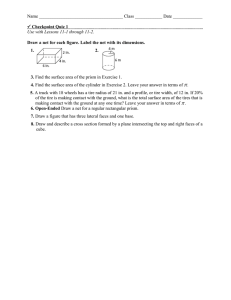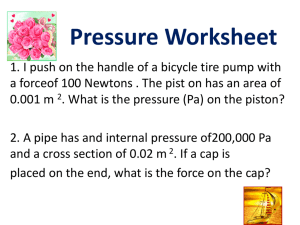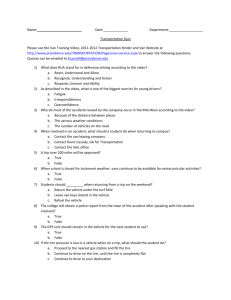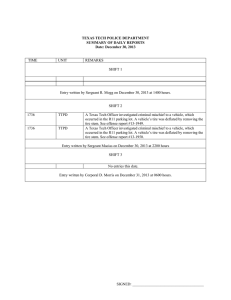general automotive repair shops safety rules
advertisement
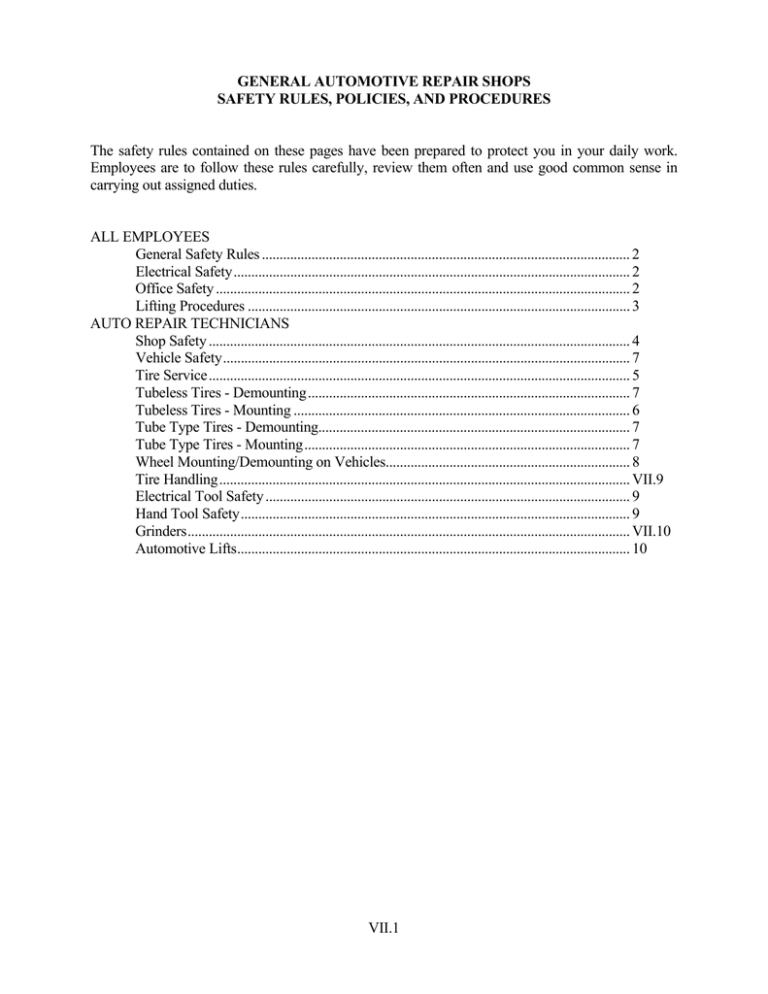
GENERAL AUTOMOTIVE REPAIR SHOPS SAFETY RULES, POLICIES, AND PROCEDURES The safety rules contained on these pages have been prepared to protect you in your daily work. Employees are to follow these rules carefully, review them often and use good common sense in carrying out assigned duties. ALL EMPLOYEES General Safety Rules ........................................................................................................ 2 Electrical Safety................................................................................................................ 2 Office Safety ..................................................................................................................... 2 Lifting Procedures ............................................................................................................ 3 AUTO REPAIR TECHNICIANS Shop Safety ....................................................................................................................... 4 Vehicle Safety................................................................................................................... 7 Tire Service....................................................................................................................... 5 Tubeless Tires - Demounting........................................................................................... 7 Tubeless Tires - Mounting ............................................................................................... 6 Tube Type Tires - Demounting........................................................................................ 7 Tube Type Tires - Mounting............................................................................................ 7 Wheel Mounting/Demounting on Vehicles..................................................................... 8 Tire Handling.................................................................................................................... VII.9 Electrical Tool Safety ....................................................................................................... 9 Hand Tool Safety.............................................................................................................. 9 Grinders............................................................................................................................. VII.10 Automotive Lifts............................................................................................................... 10 VII.1 7538 - General Automotive Repair shops ALL EMPLOYEES General Safety Rules 1. Do not block or obstruct stairwells, exits or accesses to safety and emergency equipment such as fire extinguishers or fire alarms. 2. Straighten or remove rugs and mats that do not lie flat on the floor. 3. Use a ladder or step stool to retrieve or store items that are located above your head. 4. Use the handle when closing doors, drawers and files. 5. Obey all posted safety and danger signs. 6. Use caution signs/cones to barricade slippery areas such as freshly mopped floors. 7. Do not run on stairs or take more than one step at a time. 8. Do not block your view by carrying large or bulky items; use a dolly or hand truck or get assistance from a fellow employee. 9. Do not tilt the chair you are sitting in on its back two legs. 10. Use handrails when ascending or descending stairs or ramps. 11. Do not stand in front of closed doors. 12. Walk around wet, icy, slick or oily areas if possible. 13. If required to cross a slippery surface, walk slow and flat-footed. Hold onto a handrail or solid object, if present, to maintain balance. 14. Use provided aisles, walkways or sidewalks. Do not take shortcuts. 15. Clean shoes of ice, water, mud, grease or other substances that could cause a slip or fall. 16. Pull merchandise carts through areas of restricted visibility. 17. Use a flashlight, turn on lights or take time for eyes to adjust when entering a dark room or dim surroundings. 18. Do not move faster than conditions allow on slippery surfaces or in congested areas. 19. Open one file cabinet drawer at a time. 20. Use a cord cover or tape the cord down when running electrical or other cords across aisles, between desks or across entrances/exits. Electrical Safety 1. Do not use appliances and extension or power cords that have the ground prong removed or broken off. 2. Do not connect multiple electrical devices into a single outlet. 3. Do not overload electrical circuits with multiple outlets. 4. Turn off electrical appliances and equipment when not in use. 5. Turn off and unplug office machines before adjusting, lubricating or cleaning them. Office Safety 1. Close drawers and doors immediately after use. 2. Do not kick objects out of your pathway; pick them up or push them out of the way. 3. Put heavy files in the bottom drawers of file cabinets. 4. Store sharp objects, such as pens, pencils, letter openers or scissors in drawers or with the points down in a container. 5. Keep floors clear of items such as paper clips, pencils, tacks or staples. VII.2 7538 - General Automotive Repair shops ALL EMPLOYEES Office Safety (Continued) 6. Carry pencils, scissors and other sharp objects with the points down. 7. Do not use extension or power cords that have the ground prong removed or broken off. 8. Point the ejector slot away from yourself and bystanders when refilling staplers. 9. Do not connect multiple electrical devices into a single outlet. 10. Do not throw matches, cigarettes or other smoking materials into trash baskets. 11. Keep doors in hallways fully open or fully closed. 12. Use a staple remover, not your fingers, for removing staples. 13. Turn off and unplug office machines before adjusting, lubricating or cleaning them. 14. Do not use fans that have excessive vibration, frayed cords or missing guards. 15. Do not place floor type fans in walkways, aisles or doorways. 16. Do not use frayed, cut or cracked electrical cords. 17. Do not store or leave items on stairways or walkways. 18. Clean up spills or leaks immediately by using a paper towel, rag or a mop and bucket. Lifting Procedures 1. Plan the move before lifting; remove obstructions from your chosen pathway. 2. Test the weight of the load before lifting by pushing the load along its resting surface. 3. If the load is too heavy or bulky, use lifting and carrying aids such as hand trucks, dollies, pallet jacks and carts or get assistance from a co-worker. 4. If assistance is required to perform a lift, coordinate and communicate your movements with those of your co-worker. 5. Position your feet 6 to 12 inches apart with one foot slightly in front of the other. 6. Face the load. 7. Bend at the knees, not at the back. 8. Keep your back straight. 9. Get a firm grip on the object with your hands and fingers. Use handles when present. 10. Never lift anything if your hands are greasy or wet. 11. Wear protective gloves when lifting objects with sharp corners or jagged edges. 12. Hold objects as close to your body as possible. 13. Perform lifting movements smoothly and gradually; do not jerk the load. 14. If you must change direction while lifting or carrying the load, pivot your feet and turn your entire body. Do not twist at the waist. 15. Set down objects in the same manner as you picked them up, except in reverse. 16. Do not lift an object from the floor to a level above your waist in one motion. Set the load down on a table or bench and then adjust your grip before lifting it higher. 17. Slide materials to the end of the tailgate before attempting to lift them off of a pick-up truck. Do not lift over the walls or tailgate of the truck bed. 18. When practical, push objects into position for lifting, do not pull. 7538 - General Automotive Repair shops AUTO REPAIR TECHNICIANS Shop Safety 1. Follow these steps when handling hot automotive parts that have been removed from vehicles: a) Pick up the part using gloves, heat resistant pads or dry rags. b) Place hot parts such as loose pipes, mufflers and shocks in metal containers that are labeled "Hot Metal Parts Only". 2. Wear safety glasses when working in the shop area. 3. Use a flexible exhaust hose to vent engine exhaust to the outside when the shop bay doors are closed. 4. Remove dust and shavings from drum lathes with a dust pan and broom or vacuum cleaner on a daily or job by job basis. Do not use your bare hands. 5. Dump gasoline and other liquid chemical waste into containers labeled "Flammable Waste" from containers labeled "Flammable". 6. Attach the pressure reducing nozzle that is labeled "Reduces Pressure to 30 psi" to the air hose when using compressed air to clean. Wear safety goggles when using compressed air to clean. 7. When lifting batteries or other heavy objects from the engine compartment of a vehicle, use the following procedures: 1) Press your thighs against fender by leaning into vehicle. 2) Grasp the object by lifting with both hands. 3) Keep the object close to body, with elbows close to body. 4) Turn body using feet, not twisting at waist. 5) Move the object to work bench and lower onto bench. Use arms to lower and do not bend at waist. 8. When examining under the dash, use inspection mirrors. Do not twist your body or maintain an awkward posture when trying to look under the dash. 9. Drape a shop rag over the radiator cap before venting or removing the cap from the radiator. 10. Wear gloves, safety goggles and a rubber apron when working in the battery charging area. 11. Direct engine hand tools away from rotating fan blades when the engine is running. 12. Before "running" the vehicle for an engine analysis, engage the parking brake and use wheel blocks to "chock" the wheels of the vehicle. 7538 - General Automotive Repair shops AUTO REPAIR TECHNICIANS Vehicle Safety 1. Do not ride in the bed of pick-up trucks. 2. Turn headlights on when driving inside the shop area. 3. Do not drive over 5 miles per hour in the shop area. 4. Shut all doors and fasten your seat belt before moving the vehicle. 5. Obey all traffic patterns and signs at all times. 6. Maintain a 3-point contact using both hands and one foot or both feet and one hand when climbing into and out of vehicle. 7. Drive up the slope or down the slope; not across the slope. 8. Before leaving the vehicle, engage the parking brakes and chock the wheels. 9. Do not approach any vehicle until the vehicle stops and the driver exits. 10. Walk behind the vehicle and remove any equipment, tools or other pathway instructions before getting into the vehicle. Sound the horn to alert nearby coworkers before backing the vehicle. 11. Tie down, lash, or secure all materials and equipment hauled in the bed of vehicles. 12. Stand clear of vehicles in motion. 13. Do not mount or dismount a moving vehicle. Tire Service 1. Use the positive lock-down device to hold the wheel on the tire machine before you attempt to inflate the tire. If tire is mounted on a machine that does not have a positive lock-down device, perform inflation in a safety cage. 2. Use an extension air hose with an air pressure gauge to check the tire pressure. Do not inflate beyond 40 pounds of air pressure when trying to seat the beads. If both beads are not completely seated when pressure reaches 40 pounds, completely deflate the assembly, reposition the tire and/or tube on the rim, relubricate and reinflate. 3. Inspect both sides of the tire to be sure that the beads are evenly seated. 4. After the beads are fully seated, adjust the tire pressure to meet the operating pressure labeled on the tire sidewall. 5. Replace a tire on a rim with another tire of exactly the same rim diameter designation and suffix letters. 6. Do not mount or use tires, tubes, wheels or rims that are split, cracked, cut or contain signs of other structural defects. 7. Wear leather gloves when removing rocks, glass and other foreign materials from the inside of the tire. 7538 - General Automotive Repair shops AUTO REPAIR TECHNICIANS TUBELESS TIRES-Demounting Procedures 1. Place the tire in a horizontal position on the changer with the narrow ledge of the wheel facing up. Remove valve core and allow the tire to completely deflate. 2. Center the wheel and securely fasten it onto the changer with the hold-down cone. 3. Loosen both tire beads from rim flanges. If the beads do not readily separate from the rim flange, do not force or hammer. Use the rubber tire lubricant labeled "Non-Petroleum Based Lubricant" to lubricate the tire, rotate tire to another position and try again. Never use antifreeze, silicones or petroleum-based lubricants. 4. After beads are loosened from rim flanges, lubricate the inside of the wheel and both bead areas of the tire. 5. Use a tire iron to bring the bead of the tire onto the rotating finger of the tire changer. Hold the tire bead in the center wheel well during this operation. Do not use a pipe or a makeshift bar. 6. Start the tire changer to remove the top bead from the wheel. 7. Again use the rubber tire lubricant labeled "Non-Petroleum Based Lubricant" to lubricate the tire beads and bead seat areas of the wheel including the drop-center well of the wheel. 8. Use a tire iron to raise the bottom bead and bring it over the rotating finger of the changer. Use your hip and hand to hold the side of the tire opposite the rotating finger down in the center well of the wheel. TUBELESS TIRES-Mounting Procedures 1. Do not mount a tire on a wheel rim that has molten metal scars or other signs that it has been repaired by welding or brazing. 2. Remove any oxidized rubber, dried soap solution, rust or heavy paint from the rim flanges and bead ledges (especially hump and radius) using a wire brush. Replace valve stems that are cracked, split, cut or are otherwise visibly damaged. 3. Place wheel on changer with narrow bead-ledge up. Center wheel and securely fasten it onto the changer with the hold-down mechanism. 4. Use the rubber tire lubricant labeled "Non-Petroleum Based Lubricant" to lubricate sides and bases of tire beads, rim flanges and bead ledge areas. Do not use antifreeze, silicones or petroleum-based lubricants. 5. Remove any tools, foreign objects or liquids that may be present inside the tire casing. 6. In mounting the tire, push the bottom bead first in the well of the wheel. 7. Push the top bead down into the center well of the wheel. Hold the tire in this position while the rotating finger runs the bead onto the wheel. Center tire on rim. 8. Install the valve core. 7538 - General Automotive Repair shops AUTO REPAIR TECHNICIANS TUBELESS TIRES-Mounting Procedures (Continued) 9. Tighten the hold down cone before inflating the tire. Use an extension air hose with gauge and clip-on chuck to permit operator to stand clear of the tire assembly. Slowly inflate the tire until the beads "pop" on the bead ledge of the wheel. Prior to inflating the tire, loosen the hold down cone so that it and the tire assembly can be removed later. Inflate the tire to operating pressure labeled on the tire sidewall. TUBE TYPE TIRES-Demounting Procedures 1. Remove all balance weights from the rim. Place tire in a horizontal position on changer with the narrow ledge of the wheel facing up. Remove valve core and completely deflate the tire. 2. Center the wheel and securely fasten it onto the changer with the hold-down cone. 3. Loosen both tire beads from rim flanges. If the beads do not readily separate from the rim flange, do not force or hammer. Lubricate only with rubber lubricant approved by the manufacturer and rotate tire to another position and try again. Never use antifreeze, silicones or petroleum-based lubricants. 4. After beads are loosened from rim flanges, lubricate the inside of the wheel and both bead areas of the tire. 5. Use a tire iron to bring the bead of the tire onto the rotating finger of the tire changer. Hold the tire bead in the center wheel well during this operation. Do not use a pipe or a makeshift bar. 6. Start the tire changer to remove the top bead from the wheel. 7. Starting at the valve area, remove the tube from the tire by hand. 8. Again lubricate the tire beads and bead seat areas of the wheel including the drop-center well of the wheel. 9. Use a tire iron to raise the bottom bead and bring it over the rotating finger of the changer. Use your hip and hand to hold the side of the tire opposite the rotating finger down in the center well of the wheel. TUBE TYPE TIRES-Mounting Procedures 1. Use a wire brush to remove any oxidized rubber, dried soap solution, rust or heavy paint from the wheel well, rim flanges and bead ledges (especially hump and radius) so that interior surfaces are smooth and clean. If wheel is spoked, visually inspect drop center well rim strip for rips and cracks. If necessary to replace the strip, use one-inch wide plastic electrician's tape. 2. Place wheel with the narrow bead ledge up on the changer. Center and securely fasten wheel to changer with changer hold-down cone. 7538 - General Automotive Repair shops AUTO REPAIR TECHNICIANS TUBE TYPE TIRES-Mounting Procedures (Continued) 3. Insert the tube in the tire and partially inflate to round out tube. Use a brush or cloth to apply a solution of natural vegetable oil soap or rubber lubricant to the tube base and the base of the top and bottom beads. Do not let lubricant run between the tire and tube. Do not use antifreeze, silicones or petroleum-based lubricants. 4. Mount the bottom bead on the wheel, being careful not to pinch the tube against the rim. 5. After aligning the tube valve with the valve stem hole in the rim, insert and center valve stem through stem hole in the rim. 6. Mount top bead of the tire on the rim so that the bead in the valve area will be the last part of the bead to go over the rim flange. Be careful not to pinch or disturb the tube. Recenter the valve stem if necessary, by rotating both tire and tube. Reinstall the valve core. 7. Use an extension air hose with gauge and clip-on chuck to permit operator to stand clear of tire assembly. Inflate slowly to seat tire beads. Do not exceed 40 psi to seat beads. 8. To prevent tube wrinkling or buckling, remove valve core to completely deflate the tube. Reinsert valve core and firmly seat it. 9. Reinflate assembly to the operating pressure labeled on the tire sidewall. Wheel Mounting/Demounting On Vehicle 1. Position the lift so that the axle hub of the vehicle is about waist height. 2. Position the tire and wheel on the floor so that the inside of the tire faces you and the outside of the tire faces the car. 3. Place hands on the side of the tire with the tire resting against your thigh just above the knee. 4. With a continuous motion, straighten up using your thigh as a pivot point. Rotate the tire until most of the weight is resting on your thigh. The inside of the tire is now facing the car. 5. Continuing the momentum, the tire and wheel goes toward the hub with a little guidance from the hands. 6. Position the wheel and hub hole on the hub and align the lugs with the holes. 7. Reverse this procedure when demounting. 7538 - General Automotive Repair shops AUTO REPAIR TECHNICIANS Tire Handling 1. When loading tires onto or unloading tires from a vehicle, do not throw the tires off of the truck; use the following procedure: a) Bend at knees, grasp tire with two hands, elevate tire to upright position and carry the tire to the end of the truck. b) Hand tire off to a co-worker. 2. Do not stack tires above your shoulder level. 3. When unstacking tires that are above your shoulder height, use two people to unstack down to shoulder height. 4. Carry tires with your hands. Do not carry more than two tires at a time; Do not roll tires. Electrical Tool Safety 1. Do not use power equipment or tools on which you have not been trained. 2. Keep power cords away from the path of vacuum cleaners, floor polishers and grinders. 3. Do not carry plugged in equipment or tools with your finger on the switch. 4. Do not carry equipment or tools by the cord. 5. Disconnect the tool from the outlet by pulling on the plug, not the cord. 6. Turn the tool off before plugging or unplugging it. 7. Do not leave tools that are "On" unattended. 8. Do not handle or operate electrical tools when your hands are wet or when you are standing on wet floors. 9. Turn off electrical tools and disconnect the power source from the outlet before attempting repairs or service work. Tag the tool "Out of Service". 10. Do not drive over, drag, step on or place objects on a cord. Hand Tool Safety 1. Tag worn, damaged or defective tools "Out of Service" and do not use them. 2. Do not use a tool if its handle has splinters, burrs, cracks or splits, or if the head of the tool is loose. 3. Do not use impact tools such as hammers, chisels, punches or steel stakes that have mushroomed heads. 4. When handing a tool to another person, direct sharp points and cutting edges away from yourself and the other person. 5. Do not chop at heights above your head when working with a hand axe. 6. Do not carry sharp or pointed hand tools such as screwdrivers, scribes, aviation snips, scrapers, chisels or files in your pocket unless the tool or pocket is sheathed. 7. Do not perform "make-shift" repairs to tools. 7538 - General Automotive Repair shops AUTO REPAIR TECHNICIANS 8. 9. Transport hand tools only in tool boxes or tool belts. Wear safety glasses, goggles or face shields when operating grinders. Grinders 1. Do not use grinding wheels that have chips, cracks or grooves. 2. Do not use the grinding wheel if it wobbles. Tag it "Out of Service". 3. Do not try to stop the wheel with your hand, even if you are wearing gloves. 4. Do not use grinder if it is not firmly anchored to the work bench. 5. Prior to installing a new grinding wheel, inspect the wheel for cracks or other visible damage; tap the wheel gently with a plastic screwdriver handle to detect cracks that are not visible. If the wheel has a dead sound rather than a ringing sound, do not use the wheel. 6. Do not install a grinding wheel whose labeled RPM speed is lower than the rated speed of the grinder. 7. Do not grind on the side of an abrasive wheel labeled "Type 1". 8. Do not clamp a portable grinder in a vise to use it as a bench grinder. Automotive Lifts 1. Remove all tools, cords, hoses, trash and any other debris from the lift area and wipe up all grease and oil spills before driving a car or truck into the service bay. 2. Position the lift arms, adapters and supports to the center of the lift out of the way of the car's tires before driving the vehicle into the service bay. 3. Do not stand in front of a vehicle being driven into the service bay. 4. Do not use any lift that has cracked contact pads, cracked lift arms or any other visible damage. 5. Do not use wood or concrete blocks as a substitute for an extender. 6. Use wheel blocks to chock the wheels of any vehicle on a runway lift while the vehicle is on the lift. 7. Do not leave the controls unattended while the lift is in motion. 8. Do not block or "tie open" the lift's control while the lift is in motion. 9. Do not use the engine or transmission supports or stands as a substitiute for jack stands. 10. If the vehicle begins to slip off of the lift, run in the opposite direction of the fall, but not toward a wall or work bench that might trap you between the object and the vehicle. 11. Before you lower the vehicle, remove tool trays, jack, engine and transmission stands, and any other obstructions from under the vehicle. 12. Before removing the vehicle from the service bay, position lift arms and supports to the center of the lift away from the wheels of the vehicles. 13. Do not "tie down" or override the air or control valves of the lift. 14. Do not raise vehicle with anyone inside it. 7538 - General Automotive Repair shops AUTO REPAIR TECHNICIANS Automotive Lifts 15. When raising a vehicle, use the following procedure: 1) Use the lift to raise the vehicle about one foot off the ground, then moderately push ........................................................................................................................................... the rear or front bumper of the vehicle to ensure that the vehicle frame is stably mounted on the lift support's contact pads. 2) If the frame of the vehicle is not firmly touching a support contact pad, or is slipping, immediately lower the vehicle and start over. 3) Once the vehicle is secure on the lift, lift the vehicle to the desired work height and visually check those contact points for misalignment before going under the vehicle. 16. As you raise the vehicle, you will hear a "clicking" noise which indicates that the lift's locking device is engaging. If you do not hear the "clicking" noise, stop the lift, fully lower the vehicle and use another lift. Place an "Out of Service" tag on the control switch of the damaged lift and do not use it. 17. If you will be working under a lift that will be positioned at a point below where the lift's locking device engages, place four jackstands under the vehicle's frame or suspension for additional support before working under the vehicle. 18. Wear safety goggles when working underneath vehicles.
